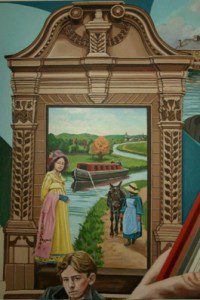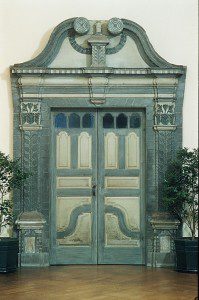 April 30, 1920: In praise of the entrance to the Landlord Fowler Tavern on East Main Street dating from 1760, The New York Times says: “Conspicuous among other acquisitions at the Metropolitan Museum of Art is a beautiful Colonial doorway taken from a house in Westfield, Mass. A valuable addition to the wonderful collection. Norman Morrison Isham says it is the best doorway he knows of the type in the valley of Connecticut.” An image of the original pine-carved doorway has been replicated in the wall mural at the Westfield Athenaeum.
April 30, 1920: In praise of the entrance to the Landlord Fowler Tavern on East Main Street dating from 1760, The New York Times says: “Conspicuous among other acquisitions at the Metropolitan Museum of Art is a beautiful Colonial doorway taken from a house in Westfield, Mass. A valuable addition to the wonderful collection. Norman Morrison Isham says it is the best doorway he knows of the type in the valley of Connecticut.” An image of the original pine-carved doorway has been replicated in the wall mural at the Westfield Athenaeum.
Harold Norton Jones wrote on the subject of Landlord Fowler’s tavern in 1979, assiduously detailing the errors put forth by the Reverend John Lockwood and Joseph Bartlett with regards to the establishment’s colonial-era history. One of Bartlett’s “Notebooks” published in 1885 gives an inaccurate account of General Burgoyne’s stay at Westfield, during which Burgoyne is said to have kissed Captain Clap’s wife. Likewise in 1922, Lockwood mistakenly identified the ‘old Burgoyne House’ at the corner of Main and Exchange Streets as Captain Clap’s Tavern located on Court Street.
With the defeat in 1777 of his army, British General John Burgoyne indeed stayed at Westfield for the night as a prisoner of war. Jones quotes Mary C. Crawford’s 1924 book Old New England Inns to set the record straight:
“The alluring adjective ‘romantic’ is conferred upon taverns for widely different reasons. This old house in Massachusetts has for years been distinguished because it was supposed to be the scene of an ardent salute bestowed upon Landlord Fowler’s wife…by the British General Burgoyne, who was then returning, a prisoner, to the Continental Camp at Cambridge…An enterprising student…arrived at the conclusion that the kisser was not Burgoyne at all, but the German General Riedesel; evidence further went to show that the kissee [sic] was in all probability the Landlord’s daughter instead of his wife…Today, therefore, the Fowler Tavern may be said to memorialize a kiss, the parties thereto being undetermined.”

Whether or not the tavern should be extolled as “romantic,” Jones confirms it as Westfield’s headquarters for revolutionary activity during the war for American independence. Built sometime between 1755 and 1760 by Samuel Fowler, Daniel Fowler became the first innkeeper in 1761. Fowler’s Tavern likely sponsored troupes of acrobats, balladeers, bear-baiters, and circus freaks to entertain its clientele as most early American taverns did (the Reverend Ballantine writes on April 9, 1764 “Saw a She Lyon at Landlord Fowlers”).
The tavern was situated in close proximity to the town meeting house on the corner of Main and Meadow Streets, so we can guess that voters spent considerable time there after exercising their civic duty, warming themselves by the fireplace and drinking brewed spirits. In the coming years Westfield patriots probably convened at Fowler’s to take inventory of the local stock of muskets and bayonets, meanwhile planning their response to the British incursion at Boston.
Following “the Bennington Alarm” Minute Men practiced marching at the Westfield training field (present-day Hampden Park), congregating at Landlord Fowler’s Tavern after a long day. In 1775, consecutive generations of Fowlers were enumerated in a list of “Westfield’s noblest citizens” recommended for membership in the Committee of Correspondence and Inspection (shortened to the “Committee of Safety”). This group reported citizens professing Tory sympathies or demonstrating unpatriotic behavior.
When Daniel Fowler died in 1802 Seth Harrison resumed operation of the tavern, although for three years after the old meeting house burned down the business turned lower profits than usual. With the advent of canal boats and the railroads, larger hotels opened in Westfield on Park Square and adjacent to the depot. For two centuries the original structure acted as a private residence; contemporaneous to Jones’ writing, Community Development Director Thomas Haberlin organized a fundraiser to support renovations of the tavern, estimated at $150,000. If Haberlin couldn’t solicit enough resources, Fowler’s Tavern would likely be torn down.
Harold Jones learned that Haberlin’s efforts had failed in May of 1979, and the Board of Health officially condemned the building. Having underwent significant restorations since then, the Landlord Fowler Tavern is now protected by the city of Westfield’s Historical Commission and functions once again as a multi-family residence.
Frances Fowler’s poem about the entrance circa 1919, still relevant, seems to match the sentiments of an entire town:
“Over that threshold, in and out
In haste or leisure, brisk or spent,
With counsel stern, or eager shout,
The land’s defenders came and went.
More than a hundred years it stood
A landmark for the country-side,
With stone-like figures carved in wood
(Perchance the worker had in mind
Some English homestead left behind),
We held it dear in heedless pride.
We cared, but did not care enough;
And one day, ere we were aware,
Through fault of none, or fault of all,
The Doorway was no longer there!”

